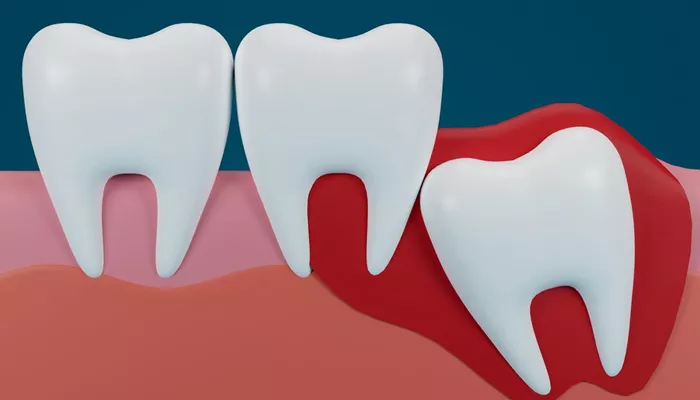Wisdom teeth, also known as third molars, typically emerge between the ages of 17 and 25. When they begin to erupt, many people experience a variety of symptoms that can range from mild discomfort to intense pain. These sensations are usually felt at the back of the mouth, behind the second molars. This article provides a detailed description of what wisdom teeth coming in feel like, along with related dental issues such as Pericoronitis and the role of Crowns in managing complications.
Early Signs of Wisdom Teeth Eruption
Mild Gum Discomfort
At the initial stage, individuals may feel a tingling or soreness in the gums. This usually occurs behind the last molars. The area may be tender to touch. It may also swell slightly. This is the gum tissue adjusting as the tooth begins to move upward.
Pressure at the Back of the Mouth
As the tooth pushes upward, a dull pressure or tightness may be felt. This is different from a sharp toothache. The sensation is often constant. It may worsen while chewing or biting down.
Inflammation and Redness
The gums may become red and inflamed. This happens when the crown of the wisdom tooth starts to break through the surface. This stage is crucial. It signals the beginning of the visible eruption process.
Common Symptoms During Eruption
Swelling in the Jaw or Cheek
Swelling is a frequent symptom. It may occur on one or both sides of the jaw. This swelling can cause mild asymmetry in the face. Applying a cold compress may offer temporary relief.
Jaw Pain and Stiffness
As the tooth moves into position, it may put pressure on surrounding structures. This includes the temporomandibular joint (TMJ). This pressure can cause stiffness and difficulty opening the mouth fully. Some may feel a clicking sound when moving their jaw.
Throbbing Pain and Headaches
Throbbing pain at the eruption site is common. This pain may radiate to the ear or head. Some individuals also report tension headaches. The discomfort may worsen at night or when lying down.
Signs of Complications During Eruption
Pericoronitis: A Common Infection
Pericoronitis is a dental infection that occurs when bacteria accumulate around a partially erupted wisdom tooth. A flap of gum tissue may trap food and plaque. Symptoms include severe pain, swelling, a bad taste in the mouth, and difficulty swallowing. Treatment may include rinsing with saltwater, antibiotics, or surgical removal of the gum flap.
Crowding and Misalignment
Wisdom teeth can cause neighboring teeth to shift. This results in crowding and misalignment. Orthodontic patients may notice a relapse in tooth positioning. Dentists may recommend extraction to prevent further issues.
Impacted Wisdom Teeth
When a wisdom tooth cannot fully emerge, it becomes impacted. Impacted teeth can grow at odd angles, pressing against adjacent teeth. This can lead to cysts, decay, or damage to nearby teeth. Surgical removal is often necessary.
What a Fully Erupted Wisdom Tooth Feels Like
Smooth Crown Sensation
Once fully erupted, the crown of the wisdom tooth feels smooth to the tongue. There should be no significant discomfort.
However, proper oral hygiene is essential to prevent cavities and gum disease.
Sensitivity to Cold or Pressure
Some individuals experience sensitivity in the new tooth. This may occur when eating cold or hard foods. The sensitivity usually subsides as the tooth settles into position.
No Pain but Slight Awareness
It’s normal to be aware of the new tooth during chewing or brushing. This awareness fades over time. Routine dental care ensures the wisdom tooth remains healthy.
When to See a Dentist
Persistent or Worsening Pain
If pain does not subside within a few days, it’s time to consult a dentist. Persistent pain may indicate infection or impaction.
Early treatment can prevent complications.
Foul Taste or Bad Breath
A bad taste or halitosis can indicate infection. Food particles trapped beneath the gum flap can cause this. A professional cleaning or further intervention may be needed.
Difficulty Opening the Mouth
Limited jaw mobility suggests inflammation near the TMJ or severe swelling. A dentist can evaluate the condition and offer treatment options such as antibiotics or surgery.
How Dentists Treat Wisdom Tooth Discomfort
Cleaning and Irrigation
During the eruption process, dentists may perform a cleaning under the gum flap. Saline or antimicrobial rinses are often used. This helps reduce bacterial load and inflammation.
Antibiotic Therapy
In cases of Pericoronitis, a course of antibiotics may be prescribed. This helps control the infection. Follow-up care ensures the problem does not recur.
Surgical Removal of the Tooth
If the wisdom tooth is impacted or causing severe issues, extraction is often recommended. The procedure is usually done under local or general anesthesia. Recovery time varies by individual.
The Role of Crowns in Wisdom Teeth Management
Protecting Damaged Teeth
When wisdom teeth erupt unevenly, they may wear down neighboring molars. Crowns can be placed on damaged molars to restore function and prevent further decay.
Post-Extraction Restorations
Although rare, some patients lose adjacent teeth due to infection. In such cases, dental Crowns may be part of the restoration plan. They help in maintaining proper occlusion.
Maintaining Oral Health During Eruption
Brushing and Flossing Carefully
Gently brush the area around the erupting tooth. Use a soft-bristled toothbrush. Flossing should be done with care to avoid irritating the gum.
Using Antibacterial Mouthwash
Antibacterial rinses can reduce plaque and infection risk. Look for alcohol-free options to avoid stinging sensitive gums.
Regular Dental Checkups
Visit your dentist every six months or as advised. X-rays can help monitor wisdom tooth development. Early intervention prevents future problems.
Conclusion
The feeling of wisdom teeth coming in varies. It may range from mild soreness to severe pain. Being aware of the symptoms and potential complications like Pericoronitis is essential. Seeking timely dental care helps ensure a healthy eruption process. In cases of damage, Crowns may be used to preserve affected teeth. Maintaining oral hygiene and seeing your dentist regularly are key steps in managing wisdom tooth growth.

